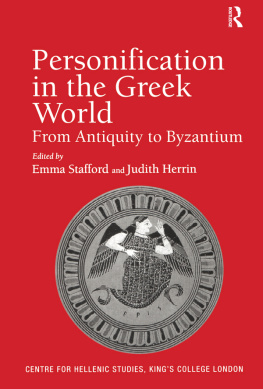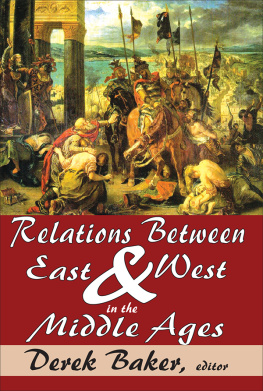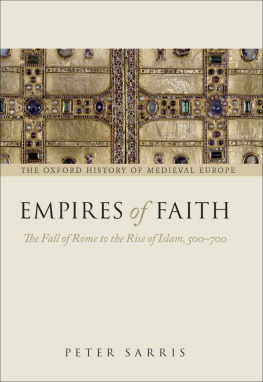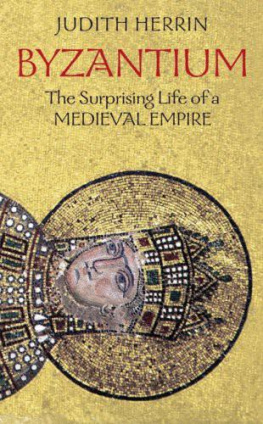
Judith Herrin
RAVENNA
Capital of Empire, Crucible of Europe

Contents
- PART ONE : 390450 :
Galla Placidia - PART TWO : 45093 :
The Rise of the Bishops - PART THREE : 493540 :
Theoderic the Goth, Arian King of Ravenna - PART FOUR : 54070 :
Justinian I and the campaigns in North Africa and Italy - PART FIVE : 568643 :
King Alboin and the Lombard conquest - PART SIX : 610700 :
The expansion of Islam - PART SEVEN : 685725 :
The two reigns of Justinian II - PART EIGHT : 700769 :
Ravenna returns to the margins - PART NINE : 756813 :
Charlemagne and Ravenna
About the Author
Judith Herrin won the Heineken Prize for History (the Dutch Nobel Prize) in 2016 for her pioneering work on the early Medieval Mediterranean world, especially the role of Byzantium, the influence of Islam and the significance of women. She is the author of Byzantium: The Surprising Life of a Medieval Empire, The Formation of Christendom, A Medieval Miscellany and Women in Purple. Herrin worked in Birmingham, Paris, Munich, Istanbul and Princeton before becoming Professor of Late Antique and Byzantine Studies at Kings College London until 2008, where she is now the Constantine Leventis Visiting Senior Research Fellow in the Department of Classics. She has excavated in Greece, Cyprus and Turkey, and served for thirty years on the editorial board of Past and Present.
To my three As: Alita, Asha and Anthony
And musing on Ravennas ancient name,
I watched the day till, marked with wounds of flame,
The turquoise sky to burnished gold was turned.
O how my heart with boyish passion burned,
When far away across the sedge and mere
I saw that Holy City rising clear,
Crowned with her crown of towers! On and on
I galloped, racing with the setting sun,
And ere the crimson after-glow was passed,
I stood within Ravennas walls at last!
Adieu! Adieu! Yon silver lamp, the moon,
Which turns our midnight into perfect noon,
Doth surely light thy towers, guarding well
Where Dante sleeps, where Byron loved to dwell.
Oscar Wilde, Ravenna
List of illustrations
Gold solidus of Theodosius I. (Photo: Dumbarton Oaks, Byzantine Collection, Washington, DC. (BZC.1948.17.866))
Gold solidus of Honorius. (Photo: Mnzkabinett, Staatliche Museen zu Berlin. Photo: Lutz-Jrgen Lbke/ 2020 Scala, Florence/BPK, Berlin)
Gold solidus of Galla Placidia. (Photo: Dumbarton Oaks, Byzantine Collection, Washington, DC (BZC.1948.17.932))
Gold solidus of Constantius. (Photo: Dumbarton Oaks, Byzantine Collection, Washington, DC (BZC.1948.17.930))
Gold solidus of Theodosius II. (Photo: Mnzkabinett, Staatliche Museen zu Berlin. Photo: Lutz-Jrgen Lbke/ 2020 Scala, Florence/BPK, Berlin)
Mausoleum of Galla Placidia, Ravenna. (Photo: Kieran Dodds)
Mosaic of St Lawrence, Mausoleum of Galla Placidia. (Photo: Kieran Dodds)
Dome of the mausoleum. (Photo: Kieran Dodds)
Dome of the Baptistery of Neon, Ravenna. (Photo: Kieran Dodds)
Dome of the Arian Baptistery, Ravenna. (Photo: Kieran Dodds)
South wall of S. Apollinare Nuovo, Ravenna. (Photo: Kieran Dodds)
The Palace (Palatium) mosaic, S. Apollinare Nuovo. (Photo: Kieran Dodds)
Mosaic showing the walled city of Classis, S. Apollinare Nuovo. (Photo: Kieran Dodds)
Mosaic of Christs healing of the paralytic, S. Apollinare Nuovo. (Photo: Kieran Dodds)
Mosaic of the Last Supper, S. Apollinare Nuovo. (Photo: Kieran Dodds)
Gold triple solidus of Theoderic. (Photo: Museo Nazionale Romano, Rome)
Theoderics Mausoleum, Ravenna. (Photo: Kieran Dodds)
Gold tremissis of Romulus Augustulus. (Photo: Roma Numismatics)
Gold tremissis minted by Odoacer in the name of the Emperor Zeno. (Photo: Bertolami Fine Arts)
Silver quarter siliqua of Athalaric. (Photo: Artemide Aste)
Bronze coin of Theodahad. (Photo: The Barber Institute of Fine Arts, University of Birmingham)
Silver half siliqua of Baduila/Totila. (Photo: The Trustees of the British Museum (1853,0716.324)
Silver half siliqua of Witigis. (Photo: Classical Numismatic Group)
Page from the Codex Argenteus. (Photo: Uppsala University Library (MS DG 1, fol. 99r))
Fragment of the Annals of Ravenna. (Photo: Domstiftbibliothek, Merseburg (Codex 202 verso))
Fragment of the Annals of Ravenna. (Photo: Domstiftbibliothek, Merseburg (Codex 202 recto))
Capital with the monogram of Theoderic, Piazza del Popolo, Ravenna. (Photo: the author)
Bronze coin of 10 nummi, with a personification of Ravenna. (Photo: Roma Numismatics)
Lead pipe from the aqueduct with inscription commemorating Theoderic. (Photo: Museo Archeologico Nazionale, Ravenna. Reproduced with permission of the Polo Museale, Emilia Romagna)
Exterior view of San Vitale, Ravenna. (Photo: Interfoto/Alamy)
Detail of apse mosaic showing Bishop Ecclesius presenting the church to Christ, San Vitale. (Photo: Classic Image/Alamy)
View of the apse and interior of the dome, San Vitale. (Photo: Kieran Dodds)
Impost block with the monogram of Bishop Victor, San Vitale. (Photo: Kieran Dodds)
Sarcophagus lid inscribed with Exarch Isaacs epitaph, San Vitale. (Photo: Kieran Dodds)
Early Christian sarcophagus re-used for the burial of Exarch Isaac, San Vitale. (Photo: Kieran Dodds)
Ivory throne of Archbishop Maximian. (Photo: Museo Arcivescovile, Ravenna)
Mosaic panel showing Emperor Justinian and his retinue, San Vitale. (Photo: Kieran Dodds)
Mosaic panel showing Empress Theodora and her retinue, San Vitale. (Photo: Kieran Dodds)
Detail of young, beardless Christ in the apse mosaic, San Vitale. (Photo: Kieran Dodds)
Detail of mature, bearded Christ from the arch in front of the apse, San Vitale. (Photo: Kieran Dodds)
Gold solidus of Justinian II, with young, beardless Christ. (Photo: The Barber Institute of Fine Arts, University of Birmingham)
Gold solidus of Justinian II, with mature, bearded Christ. (Photo: The Barber Institute of Fine Arts, University of Birmingham)
Apse of the church of Bishop Eufrasius of Parentium, Pore, Croatia. (Photo: John Elk III/Alamy)
Mosaic panel of the Visitation, church of Bishop Eufrasius. (Photo: Dusan Djordjevic)
The chapel of S. Maria in Formosa, Pula, Croatia. (Photo: the author)
Ninth-century copy of the text of the physician, Simplicius. (Photo: Veneranda Biblioteca Ambrosiana, Milan)
Gold solidus of Emperor Constans II and his son, Constantine. (Photo: Cleveland Museum of Art, Gift of Dr Norman Zaworski (2012.22))
)
Exterior of S. Apollinare in Classe. (Photo: Giorgio Morara/Alamy)
Interior of S. Apollinare in Classe. (Photo: Kieran Dodds)
Apse mosaic, S. Apollinare in Classe. (Photo: Kieran Dodds)
Mosaic portrait of S. Severus, S. Apollinare in Classe. (Photo: Kieran Dodds)
Mosaic portrait of Bishop Ursicinus. (Photo: Kieran Dodds)
The Privilegia mosaic, S. Apollinare in Classe. (Photo: Kieran Dodds)
Lead seal of the exarch Theodore. (Photo: Dumbarton Oaks, Byzantine Collection, Washington, DC (BZS.1955.1.1181)
Next page










